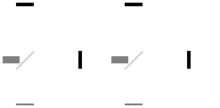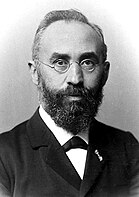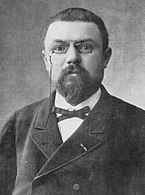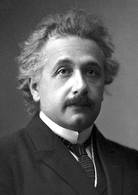
A | B | C | D | E | F | G | H | CH | I | J | K | L | M | N | O | P | Q | R | S | T | U | V | W | X | Y | Z | 0 | 1 | 2 | 3 | 4 | 5 | 6 | 7 | 8 | 9
| Part of a series on |
| Spacetime |
|---|
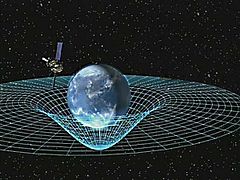 |
In physics, spacetime is a mathematical model that fuses the three dimensions of space and the one dimension of time into a single four-dimensional continuum. Spacetime diagrams are useful in visualizing and understanding relativistic effects such as how different observers perceive where and when events occur.
Until the turn of the 20th century, the assumption had been that the three-dimensional geometry of the universe (its description in terms of locations, shapes, distances, and directions) was distinct from time (the measurement of when events occur within the universe). However, space and time took on new meanings with the Lorentz transformation and special theory of relativity.
In 1908, Hermann Minkowski presented a geometric interpretation of special relativity that fused time and the three spatial dimensions of space into a single four-dimensional continuum now known as Minkowski space. This interpretation proved vital to the general theory of relativity, wherein spacetime is curved by mass and energy.
Fundamentals
Definitions
Non-relativistic classical mechanics treats time as a universal quantity of measurement which is uniform throughout space, and separate from space. Classical mechanics assumes that time has a constant rate of passage, independent of the observer's state of motion, or anything external.[1] It assumes that space is Euclidean: it assumes that space follows the geometry of common sense.[2]
In the context of special relativity, time cannot be separated from the three dimensions of space, because the observed rate at which time passes for an object depends on the object's velocity relative to the observer.[3]: 214–217 General relativity provides an explanation of how gravitational fields can slow the passage of time for an object as seen by an observer outside the field.
In ordinary space, a position is specified by three numbers, known as dimensions. In the Cartesian coordinate system, these are called x, y, and z. A position in spacetime is called an event, and requires four numbers to be specified: the three-dimensional location in space, plus the position in time (Fig. 1). An event is represented by a set of coordinates x, y, z and t.[4] Spacetime is thus four-dimensional.
Unlike the analogies used in popular writings to explain events, such as firecrackers or sparks, mathematical events have zero duration and represent a single point in spacetime.[5] Although it is possible to be in motion relative to the popping of a firecracker or a spark, it is not possible for an observer to be in motion relative to an event.
The path of a particle through spacetime can be considered to be a succession of events. The series of events can be linked together to form a line which represents a particle's progress through spacetime. That line is called the particle's world line.[6]: 105
Mathematically, spacetime is a manifold, which is to say, it appears locally "flat" near each point in the same way that, at small enough scales, the surface of a globe appears flat.[7] A scale factor, (conventionally called the speed-of-light) relates distances measured in space with distances measured in time. The magnitude of this scale factor (nearly 300,000 kilometres or 190,000 miles in space being equivalent to one second in time), along with the fact that spacetime is a manifold, implies that at ordinary, non-relativistic speeds and at ordinary, human-scale distances, there is little that humans might observe which is noticeably different from what they might observe if the world were Euclidean. It was only with the advent of sensitive scientific measurements in the mid-1800s, such as the Fizeau experiment and the Michelson–Morley experiment, that puzzling discrepancies began to be noted between observation versus predictions based on the implicit assumption of Euclidean space.[8]

In special relativity, an observer will, in most cases, mean a frame of reference from which a set of objects or events is being measured. This usage differs significantly from the ordinary English meaning of the term. Reference frames are inherently nonlocal constructs, and according to this usage of the term, it does not make sense to speak of an observer as having a location.[9]
In Fig. 1-1, imagine that the frame under consideration is equipped with a dense lattice of clocks, synchronized within this reference frame, that extends indefinitely throughout the three dimensions of space. Any specific location within the lattice is not important. The latticework of clocks is used to determine the time and position of events taking place within the whole frame. The term observer refers to the whole ensemble of clocks associated with one inertial frame of reference.[9]: 17–22
In this idealized case, every point in space has a clock associated with it, and thus the clocks register each event instantly, with no time delay between an event and its recording. A real observer, will see a delay between the emission of a signal and its detection due to the speed of light. To synchronize the clocks, in the data reduction following an experiment, the time when a signal is received will be corrected to reflect its actual time were it to have been recorded by an idealized lattice of clocks.[9]: 17–22
In many books on special relativity, especially older ones, the word "observer" is used in the more ordinary sense of the word. It is usually clear from context which meaning has been adopted.
Physicists distinguish between what one measures or observes, after one has factored out signal propagation delays, versus what one visually sees without such corrections. Failure to understand the difference between what one measures/observes versus what one sees is the source of much error among beginning students of relativity.[10]
History
By the mid-1800s, various experiments such as the observation of the Arago spot and differential measurements of the speed of light in air versus water were considered to have proven the wave nature of light as opposed to a corpuscular theory.[11] Propagation of waves was then assumed to require the existence of a waving medium; in the case of light waves, this was considered to be a hypothetical luminiferous aether.[note 1] The various attempts to establish the properties of this hypothetical medium yielded contradictory results. For example, the Fizeau experiment of 1851, conducted by French physicist Hippolyte Fizeau, demonstrated that the speed of light in flowing water was less than the sum of the speed of light in air plus the speed of the water by an amount dependent on the water's index of refraction.[12]
Among other issues, the dependence of the partial aether-dragging implied by this experiment on the index of refraction (which is dependent on wavelength) led to the unpalatable conclusion that aether simultaneously flows at different speeds for different colors of light.[13] The famous Michelson–Morley experiment of 1887 (Fig. 1-2) showed no differential influence of Earth's motions through the hypothetical aether on the speed of light, and the most likely explanation, complete aether dragging, was in conflict with the observation of stellar aberration.[8]
George Francis FitzGerald in 1889,[14] and Hendrik Lorentz in 1892, independently proposed that material bodies traveling through the fixed aether were physically affected by their passage, contracting in the direction of motion by an amount that was exactly what was necessary to explain the negative results of the Michelson–Morley experiment. No length changes occur in directions transverse to the direction of motion.
By 1904, Lorentz had expanded his theory such that he had arrived at equations formally identical with those that Einstein was to derive later, i.e. the Lorentz transformation.[15] As a theory of dynamics (the study of forces and torques and their effect on motion), his theory assumed actual physical deformations of the physical constituents of matter.[16]: 163–174 Lorentz's equations predicted a quantity that he called local time, with which he could explain the aberration of light, the Fizeau experiment and other phenomena.
Henri Poincaré was the first to combine space and time into spacetime.[17][18]: 73–80, 93–95 He argued in 1898 that the simultaneity of two events is a matter of convention.[19][note 2] In 1900, he recognized that Lorentz's "local time" is actually what is indicated by moving clocks by applying an explicitly operational definition of clock synchronization assuming constant light speed.[note 3] In 1900 and 1904, he suggested the inherent undetectability of the aether by emphasizing the validity of what he called the principle of relativity. In 1905/1906[20] he mathematically perfected Lorentz's theory of electrons in order to bring it into accordance with the postulate of relativity.
While discussing various hypotheses on Lorentz invariant gravitation, he introduced the innovative concept of a 4-dimensional spacetime by defining various four vectors, namely four-position, four-velocity, and four-force.[21][22] He did not pursue the 4-dimensional formalism in subsequent papers, however, stating that this line of research seemed to "entail great pain for limited profit", ultimately concluding "that three-dimensional language seems the best suited to the description of our world".[22] Even as late as 1909, Poincaré continued to describe the dynamical interpretation of the Lorentz transform.[16]: 163–174
In 1905, Albert Einstein analyzed special relativity in terms of kinematics (the study of moving bodies without reference to forces) rather than dynamics. His results were mathematically equivalent to those of Lorentz and Poincaré. He obtained them by recognizing that the entire theory can be built upon two postulates: the principle of relativity and the principle of the constancy of light speed. His work was filled with vivid imagery involving the exchange of light signals between clocks in motion, careful measurements of the lengths of moving rods, and other such examples.[23][note 4]
Einstein in 1905 superseded previous attempts of an electromagnetic mass–energy relation by introducing the general equivalence of mass and energy, which was instrumental for his subsequent formulation of the equivalence principle in 1907, which declares the equivalence of inertial and gravitational mass. By using the mass–energy equivalence, Einstein showed that the gravitational mass of a body is proportional to its energy content, which was one of the early results in developing general relativity. While it would appear that he did not at first think geometrically about spacetime,[3]: 219 in the further development of general relativity, Einstein fully incorporated the spacetime formalism.
When Einstein published in 1905, another of his competitors, his former mathematics professor Hermann Minkowski, had also arrived at most of the basic elements of special relativity. Max Born recounted a meeting he had made with Minkowski, seeking to be Minkowski's student/collaborator:[25]
I went to Cologne, met Minkowski and heard his celebrated lecture 'Space and Time' delivered on 2 September 1908. He told me later that it came to him as a great shock when Einstein published his paper in which the equivalence of the different local times of observers moving relative to each other was pronounced; for he had reached the same conclusions independently but did not publish them because he wished first to work out the mathematical structure in all its splendor. He never made a priority claim and always gave Einstein his full share in the great discovery.
Minkowski had been concerned with the state of electrodynamics after Michelson's disruptive experiments at least since the summer of 1905, when Minkowski and David Hilbert led an advanced seminar attended by notable physicists of the time to study the papers of Lorentz, Poincaré et al. Minkowski saw Einstein's work as an extension of Lorentz's, and was most directly influenced by Poincaré.[26]
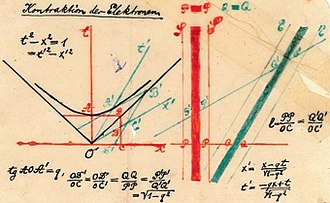
On 5 November 1907 (a little more than a year before his death), Minkowski introduced his geometric interpretation of spacetime in a lecture to the Göttingen Mathematical society with the title, The Relativity Principle (Das Relativitätsprinzip).[note 5] On 21 September 1908, Minkowski presented his famous talk, Space and Time (Raum und Zeit),[27] to the German Society of Scientists and Physicians. The opening words of Space and Time include Minkowski's famous statement that "Henceforth, space for itself, and time for itself shall completely reduce to a mere shadow, and only some sort of union of the two shall preserve independence." Space and Time included the first public presentation of spacetime diagrams (Fig. 1-4), and included a remarkable demonstration that the concept of the invariant interval (discussed below), along with the empirical observation that the speed of light is finite, allows derivation of the entirety of special relativity.[note 6]
The spacetime concept and the Lorentz group are closely connected to certain types of sphere, hyperbolic, or conformal geometries and their transformation groups already developed in the 19th century, in which invariant intervals analogous to the spacetime interval are used.[note 7]
Einstein, for his part, was initially dismissive of Minkowski's geometric interpretation of special relativity, regarding it as überflüssige Gelehrsamkeit (superfluous learnedness). However, in order to complete his search for general relativity that started in 1907, the geometric interpretation of relativity proved to be vital. In 1916, Einstein fully acknowledged his indebtedness to Minkowski, whose interpretation greatly facilitated the transition to general relativity.[16]: 151–152 Since there are other types of spacetime, such as the curved spacetime of general relativity, the spacetime of special relativity is today known as Minkowski spacetime.
Spacetime in special relativity
Spacetime interval
In three dimensions, the distance between two points can be defined using the Pythagorean theorem:
Although two viewers may measure the x, y, and z position of the two points using different coordinate systems, the distance between the points will be the same for both, assuming that they are measuring using the same units. The distance is "invariant".
In special relativity, however, the distance between two points is no longer the same if measured by two different observers, when one of the observers is moving, because of Lorentz contraction. The situation is even more complicated if the two points are separated in time as well as in space. For example, if one observer sees two events occur at the same place, but at different times, a person moving with respect to the first observer will see the two events occurring at different places, because, from their point of view, they are stationary, and the position of the event is receding or approaching. Thus, a different measure must be used to measure the effective "distance" between two events.[31]: 48–50, 100–102
In four-dimensional spacetime, the analog to distance is the interval. Although time comes in as a fourth dimension, it is treated differently than the spatial dimensions. Minkowski space hence differs in important respects from four-dimensional Euclidean space. The fundamental reason for merging space and time into spacetime is that space and time are separately not invariant, which is to say that, under the proper conditions, different observers will disagree on the length of time between two events (because of time dilation) or the distance between the two events (because of length contraction). Special relativity provides a new invariant, called the spacetime interval, which combines distances in space and in time. All observers who measure the time and distance between any two events will end up computing the same spacetime interval. Suppose an observer measures two events as being separated in time by and a spatial distance
Antropológia
Aplikované vedy
Bibliometria
Dejiny vedy
Encyklopédie
Filozofia vedy
Forenzné vedy
Humanitné vedy
Knižničná veda
Kryogenika
Kryptológia
Kulturológia
Literárna veda
Medzidisciplinárne oblasti
Metódy kvantitatívnej analýzy
Metavedy
Metodika
Text je dostupný za podmienok Creative
Commons Attribution/Share-Alike License 3.0 Unported; prípadne za ďalších
podmienok.
Podrobnejšie informácie nájdete na stránke Podmienky
použitia.
www.astronomia.sk | www.biologia.sk | www.botanika.sk | www.dejiny.sk | www.economy.sk | www.elektrotechnika.sk | www.estetika.sk | www.farmakologia.sk | www.filozofia.sk | Fyzika | www.futurologia.sk | www.genetika.sk | www.chemia.sk | www.lingvistika.sk | www.politologia.sk | www.psychologia.sk | www.sexuologia.sk | www.sociologia.sk | www.veda.sk I www.zoologia.sk



